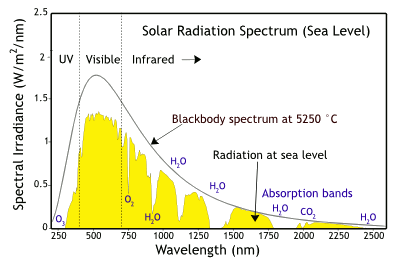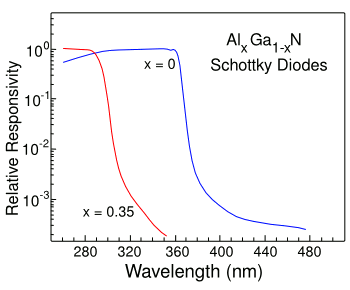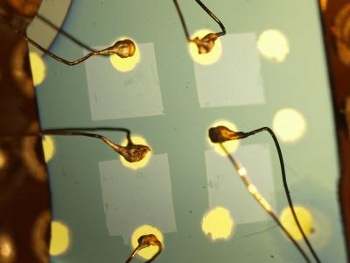Solar-Blind UV Photodetectors
October 28, 2013
Most
residential fire alarms operate as
smoke detectors, but how do you detect a fire that produces no
smoke? This is a problem when you're working with
hydrogen, since the sole
combustion product of burning hydrogen is
water. There is no smoke, and a hydrogen
flame is actually dim, since most of its
energy is not contained in the
visible spectrum of light. This is a problem even when hydrogen is stored
cryogenically, and hydrogen is more easily ignited than most
fuels.
A hydrogen flame does emit considerable
ultraviolet light (UV), and that's the basis of most hydrogen
flame detectors, which detect UV light below a
wavelength of 300
nm. The 300 nm wavelength cutoff is critical, since ultraviolet radiation from the
Sun would trigger these detectors in the absence of a flame (see figure).

The solar spectrum at sea level is shaped by absorption of the atmosphere.
(Modified Wikimedia Commons image.)
UV detectors designed to operate in daylight are called "solar-blind." Solar blind UV detectors are useful for purposes other than hydrogen flame detection. There are other
short wavelength UV ("deep" UV) emitters in the
environment worth detecting, the most notable being
corona discharges in the air. Corona discharges can occur on
high voltage electrical transmission lines, where they cause considerable
radio frequency interference, degrade
insulation, and produce
ozone.
Detectors can be made solar-blind by adding a suitable
filter, although this will
attenuate some of the UV radiation. Modern
technology allows the inexpensive fabrication of
dichroic filters with
bandpass and
bandstop characteristics. These are built from alternating layers of
transparent materials with different
refractive index. Filters can also be made from an
electrical conductor nanoscale grid, one example of which has a 27% transmission at 290 nm wavelength and a 100 nm bandwidth.[1]
A better solar-blind option than using a broadband UV detector with a filter is to make a detector that responds only to the intended wavelengths. As shown in the figure, the threshold wavelength for optical absorption can be tuned in some materials such that the only response will be at solar-blind wavelengths.

Response of Al(x)Ga(1-x)N Schottky diodes.
Data from Muñoz, et al.,[2] referenced in fig. 26.2 of ref. 3.[3]
(Illustration by the author using Inkscape.)
Scientists at
Ishinomaki Senshu University (Ishinomaki, Japan) have been developing a particular type of solar-blind
photodiode with a
heterojunction.[4-5] In a standard diode,
n- and p-doped versions of the same material (e.g.,
silicon) are used to make the
diode junction. In a heterojunction diode, the junction is between dissimilar materials with different
band gaps. Heterojunctions are used to advantage in
solid state optical devices and high speed
transistors, and the 2000
Nobel Prize in Physics was awarded to
Herbert Kroemer and
Zhores Alferov for heterojunction research.
The hetereojunction of the Japanese device was formed between
beta-gallium oxide (β-Ga
2O
3) and
silicon carbide (
6H-SiC). The device was formed by
evaporation of
gallium in an
oxygen plasma onto a substrate of p-type 6H-SiC.[4] The heterostructure solved the problem that it's not possible to make p-type gallium oxide.[5] The band gap of the β-Ga
2O
3, 4.9
eV, and that of the 6H-SiC, 3.02 eV, gave a
linear current response with UV illumination under a
reverse-bias condition. The response time was a few
milliseconds.[4]

Solar-blind UV β-Ga2O3/SiC heterojunction photodiode developed at Ishinomaki Senshu University.
(Ishinomaki/S.Nakagomi, Ishinomaki Senshu University.)[5)]
![]()
References:
- Wen-Di Li and Stephen Y. Chou, "Solar-blind deep-UV band-pass filter (250 - 350 nm) consisting of a metal nano-grid fabricated by nanoimprint lithography," Optics Express, vol. 18, no. 2 (January 18, 2010), pp. 931-937. Available as a PDF file, here.
- E. Muñoz, E. Monroy, J.L. Pau, F Call, F Omnès and P Gibart, "III nitrides and UV detection," J Physics Condensed Matter, vol. 13, no. 32 (August 13, 2001) pp.7115-7137.
- U. Schühle and J.-F. Hochedez, "Solar-blind UV detectors based on wide band gap semiconductors," Chapter 26 of Observing Photons in Space, M. C. E. Huber, A. Pauluhn, J. L. Culhane, J. G. Timothy, K. Wilhelm, and A. Zehnder, Eds.), pp. 429–439 (PDF File).
- Shinji Nakagomi, Toshihiro Momo, Syuhei Takahashi and Yoshihiro Kokubun, "Deep ultraviolet photodiodes based on β-Ga2O3/SiC heterojunction, Appl. Phys. Lett., vol. 103, no. 7 (August 12, 2013), Document No. 072105 (4 pages).
- A better device to detect ultraviolet light, American Institute of Physics Press Release, October 4, 2013.
Permanent Link to this article
Linked Keywords: Residence; residential; fire alarm; smoke detector; smoke; hydrogen; combustion product; water; flame; energy; visible spectrum of light; cryogenics; cryogenically; fuel; ultraviolet light; flame detector; wavelength; nanometer; nm; Sun; sunlight; solar spectrum; sea level; electromagnetic radiation; absorption; atmosphere of Earth; Wikimedia Commons; short wavelength UV; environment; corona discharge; high voltage electrical transmission line; electromagnetic interference; radio frequency interference; insulator; insulation; ozone; filter; attenuation coefficient; technology; dichroic filter; bandpass; bandstop; transparency; transparent; refractive index; electrical conductor; nanoscopic scale; nanoscale; aluminium; Al; gallium; Ga; nitrogen; N; Schottky diode; Inkscape; scientist; Ishinomaki Senshu University (Ishinomaki, Japan); photodiode; heterojunction; doping of semiconductors; n-doped; p-doped; silicon; diode; junction; band gap; solid state; transistors; Nobel Prize in Physics; Herbert Kroemer; Zhores Alferov; beta-gallium oxide; silicon carbide; polymorphs of silicon carbide; 6H-SiC; evaporation; deposition; oxygen; plasma; electronvolt; eV; transfer function; linear current response; reverse biasing; reverse-biased; millisecond.